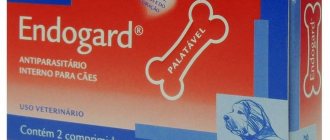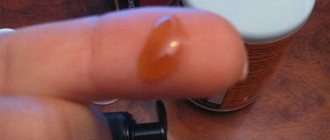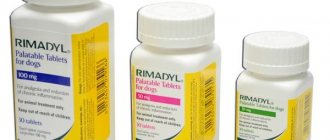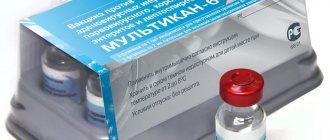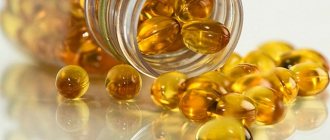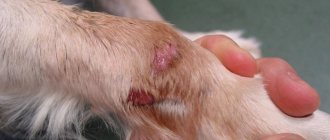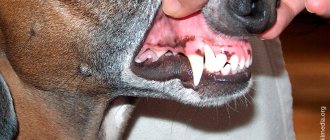Biological properties and action
Sulfur cannot “work” in dry form, but in a humid environment it forms hydrogen sulfide, oxygen, and sulfur dioxide, which have a positive effect on the animal’s body. If the substance is used externally, it has a keratolytic effect on the skin.
Sulfur helps get rid of parasites due to hydrogen sulfide and sulfur dioxide. When taken orally, the substance forms hydrosulfite and sodium sulfite, which irritate the intestines and act as a laxative.
Some of the sulfur is not excreted in the feces, but remains in the intestines, forming hydrogen sulfide. This substance helps to increase the tone of autonomic innervation, increases the ability to neutralize toxic substances, and enhances the body’s protective function.
Dogs' sulfur needs are met by a number of amino acids: L-cystine, biotin, L-methionine and thiamine. Animals need them for proper and rapid hair growth. The supplement is useful for dermatological problems: eczema, scabies, trichophytosis. But for these purposes they do not use the food version, but sulfur-based ointments.
How to use sulfur
- Wear waterproof gloves. Mix 120ml lime sulfur with 4 liters of warm water in a mixing container. It is important to first add lime sulfur to the mixing container and then add warm water. Pour the diluted solution into the spray bottle and close the nozzle. Set aside.
- Remove gloves and wash your hands. Apply some Vaseline or mineral oil around the eyes to protect your dog's eyes from wax. Additionally, place a drop of mineral oil in each eye to protect against irritation. Place the dog in a laundry sink with drain or in a bathtub.
- Bathe your dog with a mild, cleansing shampoo. Change gloves to avoid skin contact. Saturate the entire fur from the neck to the tip of the tail. Bring the sprayer to the skin and press it onto the skin.
- Dampen a sponge with a diluted solution of lime sulfur and gently pat the face and ears. Be careful not to get the solution in your eyes.
- Put on an Elizabethan collar, a truncated cone that prevents the dog from licking its fur until the lime-sulfur solution dries. Allow the solution to dry without intervention. Do not towel dry your dog. Do not try to speed up drying time.
- Repeat every five to seven days for six weeks.
© shutterstock
Warnings Always wear gloves when handling lime sulfur, especially in concentrated form. Do not apply lime-sulfur sauce to your dog without diluting it. It can be toxic in concentrated form. Remove all jewelry before using sulfur. Sulfur may change the color of some jewelry. It can also discolor porous surfaces and temporarily stain the fur of light-colored pets. Sulfur has a strong odor, so it should only be used in well-ventilated areas. Wash the work area thoroughly with soapy water.
Directions for use and dosage
Fasting or special diets are not required before taking the feed additive. To improve your pet's digestion or to prevent skin diseases and improve coat, sulfur should be taken daily.
Course duration – 1 month. It is not advisable to skip doses, but if this happens, then do not stop the course, just skip one day and continue to give the drug (at the usual dosage).
The dog should be given from 0.05 to 0.2 g of sulfur per day. The amount of dietary supplement depends on the size of the animal. For small dog breeds, a minimum dose of 0.05 g is sufficient, for medium-sized dogs – 0.1 g, and for large dogs – 0.2 g.
For serious skin diseases (domodex mange, etc.), the dose can be increased, but it should not exceed 0.4 g per day.
Sulfur for dogs
This feed additive has a fairly wide spectrum of action. It not only improves the appearance of the coat, but also improves immunity, helps with poisoning, and has a laxative effect. How to give it to dogs?
You should always remember that only an experienced veterinarian can be trusted to make all decisions regarding the treatment of a pet, since no one else will be able to perform a correct examination and give an opinion with recommendations for treatment in each of the possible situations.
Can AVZ sulfur for animals be used and used by people, drink it and how does it differ from sulfur for people and human skin?
Sulfur is almost identical for animals and people. But for humans, this drug is prepared in the prescription departments of pharmacies. It is believed that the degree of purification of a sulfur preparation for humans should be higher than for animals. Therefore, its price will be much higher.
Sulfur for dogs instructions for use, how and how many days to give, dosage
Use sulfur for dogs for a month. Can be added to food. The dose depends on the weight of the animal and ranges from 0.05 to 0.2 grams per dog. For demodicosis and scabies, in combination with other medications, give 0.04 g of the drug per 1 kg of weight, but not more than 1 g per day per dog.
Sulfur for dogs use price, reviews, cost, where to buy food in tablets
Sulfur for dogs is not available in tablet form in its pure form. It can be found in combination with vitamins or brewer's yeast. You can buy tablets at a regular pharmacy. They are sold in plastic jars with a lid, 100 pcs. The price of one jar is about 260 rubles. Since in addition to sulfur, the tablets contain vitamins for humans, you should consult your veterinarian about the possibility of use.
Sulfur powder for dogs costs about 20 rubles, one 2.5 g sachet. A course of treatment requires about 2 sachets. For a small dog or cat, one packet is enough, the powder will even remain.
Reviews about the use of medical sulfur for animals with hair problems are very good. The quality and thickness of the coat, as well as the condition of the skin, noticeably improve after undergoing a course of treatment with the inclusion of sulfur preparations.
Sulfur for dogs for allergies, acne, anti-shedding
Teenagers and adults with problem skin take sulfur for acne. Sulfur is given to dogs for allergic diseases in combination with other drugs that help restore the animal’s normal condition, improve its coat and skin condition.
When molting, sulfur helps animals speed up the growth of new fur. Makes it thicker and shinier.
Sulfur for animals feed additive composition, how to measure the dose
For animals, as for humans, sulfur is a building material for the molecules of the body. It also helps the proper functioning of metabolic processes and has anti-inflammatory and bactericidal properties.
The daily dose of sulfur for cats and small dogs is 0.05 g. To measure it accurately, you can buy a pharmacy scale. If such a purchase is not part of your plans, ask the pharmacy to measure out such a dose for you once so that you can visually represent it. Some people use a simple definition of measure - at the tip of a knife. For large dogs, the dose of sulfur should be four times greater - 0.2 g per day. Visually, this dose can be represented in the form of a pea.
Food sulfur for dogs: side effects, benefits, overdose
This drug is prescribed to improve the condition of the skin and coat for various dermatological problems. Can be used as a preventive measure to keep the coat beautiful and shiny. This is the main effect of the drug. In addition, sulfur has a mild laxative effect, being released through the lungs in the form of hydrogen sulfide, it helps to expectorate excess mucus, and removes heavy metals and toxic substances from the body.
It is necessary to accurately select the dose and use only highly purified sulfur for oral administration to avoid side effects such as poisoning.
Add a comment Cancel reply
Recommendations for admission
The use of sulfur for dogs is necessary if they:
- suffer from metabolic problems;
- have skin diseases or age spots;
- suffer from dandruff;
- have dull coats that are prone to falling out.
In order for the animal to no longer encounter the above problems, you need to find the cause of the “problems” in the body.
To begin with, review the animal’s diet; dogs should be fed only fresh, high-quality food, and should not be given fatty, fried or sweet foods. Salty foods are also prohibited. To get professional advice, you should contact your veterinarian.
The substance can be used not only as a food supplement, but also as a medicine; it is used for chronic polyarthritis, rheumatic muscle inflammation and nerve paralysis.
But in this case, a veterinarian’s consultation is required, because for such severe diseases the dose must be calculated individually.
What is sarcoptic mange?
This is one of the most common questions dog owners who have no experience treating canine mange ask their veterinarians. Sarcoptic mange is best described as mange in dogs. This disease is caused by ticks in dogs.
The mites burrow into the dog's skin and cause allergic reactions that lead to inflammation of the dog's skin. If the mites are not eliminated by topical remedies such as sulfur and others; Scabies can easily develop into more serious sepsis, especially when infected with secondary bacteria.
© shutterstock
Contraindications and side effects
Sulfur for dogs is used at any age, the breed of the pet also does not matter. But, despite the fact that the product has no contraindications, side effects may occur if the dosage is calculated incorrectly or the expiration dates are ignored.
You can tell that something is wrong by the following symptoms:
- diarrhea;
- refusal to eat;
- lethargy;
- drowsiness;
- nausea and vomiting;
- increase in body temperature.
These signs indicate an overdose or poisoning. Having noticed at least two or three of them, you need to call a veterinarian or take the dog to a veterinary clinic.
You should not treat the animal yourself; you may make the problem worse. It's better to just wait for the doctor.
Before the doctor arrives, try not to touch the pet; place it in a dark, well-ventilated room. Make sure the room is quiet and there is a bowl of clean water near the dog.
Rapid diagnosis and treatment required
When your dog suffers from sarcoptic mange, you need to immediately seek help from a veterinarian or find the best treatment. Diagnosis of sarcoptic mange must be made quickly and treatment carried out as soon as possible to prevent the disease from degenerating into a chronic problem. Treatment for sarcoptic mange is only topical application, in which sulfur is present, and other injections such as antibiotics when the sores caused by the mites are infected with bacteria.
You may want to know how to treat mange in dogs. One of the popular home remedies among dog owners to treat mange in dogs is sulfur. This is a home remedy that has been used for decades with good results reported.
Given that sarcoptic mange is a highly contagious disease, the use of sulfur to prevent the transmission of sarcoptic mange is also beneficial in nurseries. When one dog is infected, the likelihood of spread to the entire kennel is very high.
Shelf life and storage
In order for the use of food sulfur for dogs to produce results, you need to take the storage of the drug seriously. It should be stored in a dry, dark place out of reach of small children and pets. The sulfur should not be exposed to direct sunlight. It is also not recommended to store the substance near feed or food.
The shelf life of the drug is 3 years, when opening the package – up to 30 days. There is no need to buy large packages, you won’t have time to use them, it’s better to opt for sachet bags.
How to treat gray dogs with mange
Sulfur for treating mange in dogs has been proven to work. Sulfur is effective in the form of sulfur-lime ointments, which are even recommended for puppies. When using lime sulfur for dipping dogs; you should dilute the sulfur with water to make it more effective and less harmful to your dog's skin. When dipping, be careful not to get the sulfur in your dog's eyes or mouth. Sulfur drops alone may not be effective, especially if your dog has diffuse skin inflammation. You may add a corticosteroid or as recommended by your veterinarian to prevent skin inflammation.
Reviews
Veronica, Krasnodar
“I often buy various vitamin complexes for my dog to prevent skin problems and hair loss. Not all remedies are effective, but some help quite well. I recently came across an article about the benefits of sulfur for dogs and decided to try it on my Wolfie. After a month's course, the hair really became better, dandruff disappeared, and appetite improved. I don’t know if the latter is related to the intake of sulfur, but there is definitely a result!”
Svetlana, Voronezh
“A month ago I encountered an unpleasant phenomenon: my dog began to shed heavily and almost became bald in a very short time. At first I decided to help the animal myself, bought expensive food, gave vitamins, but nothing helped, the situation only got worse. I went to the vet, he recommended food sulfur. After 30 days of treatment (they didn’t miss a single day!) the dog’s coat became even better than before shedding (thick, shiny, silky). I definitely recommend this product to anyone who has encountered the same problem.”
Publications in the media
Sulfur compounds occur as intermediates and/or by-products in various natural and industrial processes; Hydrogen sulfide is formed in sewer systems and wells; sulfur dioxide (sulfur dioxide) is part of urban smog (emissions from industrial enterprises) and occurs during industrial accidents; poisoning with carbon disulfide (carbon disulfide) is observed in the production of viscose fibers (silk, cord, staple), cellophane, in the chemical industry (solvent), in agriculture (insecticides). The course of poisoning can be acute, chronic, progressive • Carbon disulfide (CS2) •• Liquid boiling at a temperature of 42 ° C; ignites at 117 °C •• Accumulates mainly in the liver, kidneys ••• 90% is metabolized and excreted in the urine, 10% is excreted unchanged through the lungs ••• Lethal dose when ingested - 1 g, highly toxic concentration in the air - more than 10 mg/l • Hydrogen sulfide (H2S) •• Colorless gas with a characteristic odor of rotten eggs •• Toxic concentration in the air is 0.02–0.2 mg/l, lethal - 1.2 mg/l • Sulfur dioxide (SO2) - a colorless gas with a very pungent irritating odor.
Etiopathogenesis • Carbon disulfide •• Pronounced local irritant effect •• Psychotropic, neurotoxic effects: carbon disulfide has a pronounced tropism for the deep structures of the brain, disrupts vegetative-vascular and neuroendocrine regulation •• Binding with amino acids, formation of dithiocarbamic acids, blockade of copper-containing enzymes, disturbance of vitamin metabolism PP, group B, serotonin, tryptamine • Hydrogen sulfide and sulfur dioxide - local irritant effect, selective neurotoxic effect caused by tissue hypoxia.
Clinical picture • Carbon disulfide •• Acute intoxication ••• At the site of contact with the skin, mucous membranes of the mouth, eyes - hyperemia, blisters with serous contents ••• When ingested - a slight garlic odor from the mouth, nausea, vomiting, abdominal pain • •• In mild forms, the clinical picture resembles intoxication and is reversible. ••• In moderate poisoning – headache, dizziness, ataxia, convulsions, loss of consciousness, unconsciousness is replaced by mental and motor agitation ••• In severe forms – coma, relapses convulsions, paralysis, respiratory depression, possible death •• Chronic intoxication ••• Initial stage - vegetative-vascular dystonia, cerebral asthenia, mild vegetosensory polyneuropathy ••• Stage of organic disorders - encephalopathy (characterized by a variety of cerebral syndromes), hallucinations, senestopathies, depression, often persistent arterial hypertension, hyperlipidemia. In severe cases, encephalomyelopolyneuritis or parkinsonism may develop • Hydrogen sulfide •• Burning and pain in the eyes, lacrimation (subacute keratoconjunctivitis), blepharospasm (one of the characteristic signs), rhinorrhea •• Headache, dizziness, psychomotor agitation •• Nausea, vomiting, diarrhea • • Feeling of tightness and pain in the chest, cough, shortness of breath, signs of diffuse bronchitis •• In severe cases - coma, convulsions, collapse, toxic pulmonary edema; possible fulminant death (apoplectic form) • Sulfur dioxide •• Irritation of the respiratory tract - sneezing, coughing (sometimes - hemoptysis), shortness of breath, wheezing in the lungs •• Possible nausea, vomiting •• In severe cases - toxic pulmonary edema.
Special research methods . A chest x-ray shows diffuse pinpoint infiltrates in the lungs, signs of pulmonary hypertension or pulmonary edema (in severe cases).
TREATMENT Management tactics • Hospitalization to a poison control center • Removal of the victim from the affected area (in case of poisoning with carbon disulfide, sulfur dioxide) • In case of contact with the skin, mucous membranes - rinse with running water • In case of ingestion - gastric lavage through a tube • Antidote therapy (in case of hydrogen sulfide poisoning ) • Forced diuresis • Oxygen therapy, hyperbaric oxygenation • Symptomatic therapy. Specific (antidote) therapy for hydrogen sulfide poisoning • Amyl nitrite - inhalation 0.2 ml for 30 seconds every minute • Sodium thiosulfate is contraindicated.
Symptomatic drug therapy • For convulsions - diazepam 10 mg IV • Drugs that improve metabolism and blood supply to the brain and peripheral nervous system (for example, pyridoxine, pyritinol) • For indomitable cough - codeine orally • Bronchodilators • GC (prednisolone 2-5 mg /kg IV) • For hydrogen sulfide poisoning - 10 ml of 10% solution of calcium chloride or calcium gluconate IV • Antibiotics. Prognosis • Carbon disulfide - after emerging from a coma, encephalopolyneuritis is formed • In case of functional disorders of the central nervous system, even in the initial stage, transfer to work that excludes contact with carbon disulfide is necessary • In severe forms, working capacity is permanently reduced.
ICD-10 • T59.1 Toxic effect of sulfur dioxide • T59.6 Toxic effect of hydrogen sulfide

